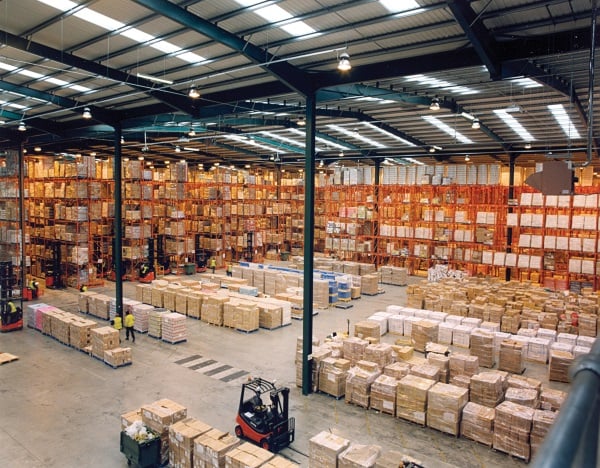
One of the most effective ways of saving money throughout your supply chain is to improve the efficiency of your warehouse. The way your warehouse is set up to accommodate your business can make the difference between a streamlined warehouse and an inefficient operation.
The six layout tips below are inexpensive ways you can optimise the space you already have without having to make any major structural adjustments to your warehouse.
1) Reduce congestion at Inbound and Outbound Areas
A critical area of your warehouse is the Inbound and Outbound areas, where incoming goods are unloaded and picked goods are sorted and loaded onto lorries. At any given time, this area can have the highest concentration of staff and equipment. It is therefore very easy for the space to become congested and chaotic, leading to mistakes and frustrating delays.
The best way to avoid this is to resize the area in order to reduce the pressure on space. Some warehouse managers are reluctant to do this as they see the additional space as wasted potential that could be used for storage, but this is not the case. The savings you make in time and mitigating transport delay, and therefore money, by avoiding pandemonium in the goods-in/out area allow for a more efficient use of space, and a faster turnover of goods throughout the warehouse. An efficient dispatch and reception area yields you greater returns from the storage space you do have, by facilitating an effortless flow of goods.
2) Minimise pick route
In a typical warehouse, one of the greatest causes of waste is unnecessary travel time between picks. The reason for this is clear; the longer a pick route, the more time it will take and therefore the more it will cost. Pick routes are often inefficient because they are not planned sufficiently in advance, and they are allowed to change organically over time. The result is a network of routes that are poorly structured, overlap each other and do not always take the shortest route from A to B. Reviewing all your pick routes will reveal immediate ways to create a leaner warehouse operation, and will allow you to reassess where you place your stock for maximum efficiency.
3) Add cross aisles when rack runs are long to allow routes to be shortened
Making your warehouse team travel up long aisles, only to double back again down another aisle to pick the stock they need can needlessly add to your pick route distance. Adding additional cross aisles to your warehouse increases the possible routes available to your team, allowing you to cut distances and save valuable time.
4) Avoid “dead ending” aisles
The most efficient warehouse layouts allow a smooth flow of movement from one area to the next, minimising congestion and journey distances. The presence of dead-end aisles means that the journey has to be traversed twice to get to the next location. This can really add up in terms of additional journey time, and you also risk congestion when returning employees meet people needing to go the other way.
5) Reset Beam Heights
Do your beam heights correspond to the actual dimensions of the product and its distribution units you use? In many cases this isn’t the case when a warehouse is reassigned for use with a different product or container size. Once you have redesigned your pick routes and decided on the best placement for your stock, you may want to reset your beam heights to maximise the cube available to you in that area. The key is to adjust your warehouse layout to accommodate your stock, not to squeeze your stock in to match your warehouse layout.
6) Add extra beam levels
It is common for warehouses to have a vast amount of space between top of pallet loads to the underside of the beam above that is unused. You can usually capitalise on this space by inserting extra levels of beams, vastly increasing the optimisation of storage area available to you.
If there is spare headroom over the racking find out if the rack frames have the capacity to allow extensions to be spliced on the top and an additional beam level added – you might need a different or modified fork truck to reach the higher beam level.
Starting from the bottom up
Optimising your warehouse starts not with changing the big, strategic picture, but by looking at the minute by minute tasks of operatives on the ground. Important efficiencies can be made by reorganising a task so that instead of taking ten minutes it now takes five. Reducing physical travel distances, cutting congestion and making better use of space lower your warehousing costs by making it quicker and easier for your team to carry out their jobs. The savings are then felt all the way up the supply chain.
To find out more, take a look at our free e-book “The Warehouse Productivity Guide”, which can be downloaded from our website.


